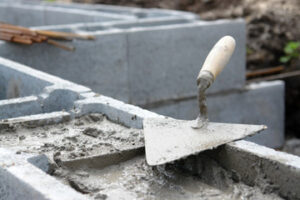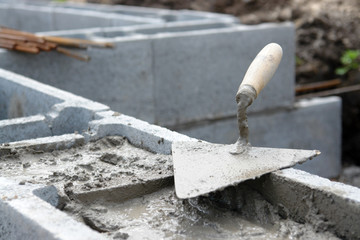Colorado Springs Masonry has been one of the oldest construction practices. It’s also the material that has built most of the world’s long-lasting structures, temples, and monuments.
Brick and concrete blocks are the most common types of masonry in industrialized nations. These materials may be load-bearing or non-load-bearing, and many have hollow cores that can be filled with concrete or steel reinforcement (typically rebar). The cores of these blocks provide great compressive strength but less tensile or lateral strength.

Concrete is one of the most common materials used in masonry construction. It is an extremely durable material that can withstand many weather conditions. It is also energy efficient and requires less maintenance over the long term. Most masonry structures are built using concrete blocks, but other concrete forms are also used. Choosing the right type of concrete is crucial for the integrity of your structure.
Masonry cement is a mixture used to bond brick, stone, and other masonry materials together. It is typically made from Portland cement and aggregates. Still, it can include other admixtures, such as air-entraining agents and water-retentive additives, to improve its workability and ability to adhere to other masonry materials.
A concrete masonry unit (CMU) is a standard-size block used in building construction. These blocks are manufactured from a combination of cementitious materials, aggregate, and admixtures and are often reinforced with steel mesh to add strength. Concrete blocks can be solid or hollow and are used in load-bearing and non-load-bearing applications.
These blocks can be stacked and butted together to create walls, floors, ceilings, and roofs. They are also used as a facing for exterior walls or as part of a concrete slab foundation. CMUs are generally produced at a block plant by mixing, placing, and vibrating the ingredients in a mold to form an integral, hollow, or solid masonry unit. The blocks are then cured at the block plant.
Concrete masonry units are often made with a hollow center for weight reduction and to provide better insulation. They can also be produced with various surface textures, colors, and shapes to create architectural variation. Concrete stretcher blocks, for example, are designed to connect the corners of a wall and are available in several different sizes.
Most masonry structures require interior insulation in fiberglass batts or rigid foam boards covered with drywall or plaster. Insulation reduces heating and cooling costs and can make a building more comfortable. The choice of a building material is usually determined by the availability of local supplies and the construction cost. A masonry building in areas with limited construction sites allows construction to proceed without much need for staging. This can help save on-site preparation time and avoid delays while waiting for delivery of other building materials.
Bricks are rectangular building blocks, often characterized by their distinctive color and texture. They can be molded and subjected to intense heat or curing to achieve their renowned strength, durability, and resistance to water damage. Different types of bricks cater to varying requirements and aesthetic preferences, from rustic clay-based units to sleek concrete blocks.
Brick masonry is commonly used to create walls and other structural elements. It can be used in load-bearing walls and decorative wall coverings like brick veneer construction. A brick veneer can be affixed to a rough masonry wall of another material, such as wood or concrete, which provides weatherproofing and gives the structure a more finished appearance.
A brick can be hollow or solid and is typically formed by kiln-burning and drying clay in a high-temperature furnace. It can also be molded, extruded, and cut mechanically to meet specific dimensions and performance criteria. The manufacturing method for a brick can provide insights into its structural performance, particularly under lateral loading. Hollow brick masonry walls should be designed to have sufficient deformation capacity in the nonlinear range so that they do not experience early damage and brittle response, which can lead to the failure of the entire structure.
The maximum height of a brick wall depends on its intended use and the design of the foundation. For instance, a wall to support a roof must be reinforced with concrete lintels to resist the loads exerted. In addition, the masonry must be properly anchored to the foundation, which can be achieved with brick or steel ties.
It is also important to consider the type of mortar used in a masonry structure. A proper ratio between cement and water should be established to avoid weakening the bricks. Masonry walls requiring a large amount of water should be adequately waterproofed using a hydrophobic sealant to prevent algae growth and other moisture-related damage.
Bricks required for a masonry project should be thoroughly soaked in clean water for an hour before use. The soaking process helps remove any sulfates and chlorides that may affect the quality of the final product. It is also advisable to regularly check the verticality of brick walls with a spirit level and a plumb bob to ensure that they are correctly aligned.
Stone is one of the most common materials used in masonry. It may be a natural substance, such as granite or sandstone, or it may be manufactured, such as clay bricks or concrete blocks. Stonemasons work with various tools, from hand-held hammers and mallets to frame and circular saws, molding and surfacing machines, and lathes. The stones themselves may come from surface pits or be sourced in quarries. The construction of structures with stone is among the oldest activities and professions in human history, with examples including Gobekli Tepe, Angkor Wat, Cusco’s Incan Wall, and Chartres Cathedral.
In stone masonry, the material of the walls is selected with consideration to both its strength and appearance. The stones must be robust, long-lasting, and hard. They also must be free of cavities, sand holes, or fractures that could compromise the structure’s integrity. Various types of stone are available for use in masonry construction, including sandstone, limestone, marble, and laterite. The kind of stone chosen depends on the availability of the mineral, the pigment it contains, and the load-bearing capacity required by the masonry project.
Dry rubble masonry is the least costly type of stone construction, and it can be constructed from various materials. The stones are generally of varying sizes and placed in a random pattern. This produces a rustic yet sturdy construction. To increase the strength of such walls, a course of thin, long stones or bricks is often installed at 1- 2m vertical intervals.
Fine-tooled ashlar masonry is a more expensive form of stone masonry constructed using square or rectangular block-shaped stones with very fine bed and end joints. The exposed face of the rocks is not dressed but left rough to produce a rugged appearance that harmonizes with the more finely-tooled beds and edges of the stonework. The mortar used in this type of masonry is lime and cement-based. Post-tensioning is commonly employed in this type of construction to improve the capacity of the stone components to resist tensile forces that could cause them to crack or fail.
Composite masonry is a wall construction type that uses different building materials. It can be made with either stone or brick or both. Combining these materials can provide a more unique look while increasing durability and strength. Composite masonry is frequently used in building facades, retaining walls, and fireplaces.
The basic idea behind composite masonry is that the wythes of different types of material are closely bonded together to form a solid unit. This design combines the aesthetic appeal of a facing material, such as brick, with the strength and cost-effectiveness of a backing material like concrete or CMU.
This type of masonry is often used in buildings to add visual interest and to create a more appealing architectural style. It can also be a good way to reduce the weight of a building since fewer materials are required. This masonry method is often combined with post-tensioning, providing an additional axial load to the structure and increasing resistance against lateral forces.
A common technique for building a masonry wall is to use concrete blocks. These blocks are stacked one on top of another and then filled with mortar. This helps ensure the block is secure and will not fall during construction.
Masonry is also commonly built using other materials such as sandstone and marble. These stones are often combined with mortar made from cement and limestone. In addition to being aesthetically pleasing, these stones are durable and require little maintenance. In some cases, these stones are also reinforced with steel bars to increase their structural performance.
Other types of masonry are constructed with a mixture of bricks and other materials, such as concrete or wood. These mixes can be useful to achieve specific structural requirements, such as using recycled materials or a more environmentally friendly product. Testing the resulting mixtures for their proper performance is important in these cases.
One of the most popular types of masonry is ashlar faced with brick backing. In this construction, rough tooled and chamfered stones are provided on the facing to appear as if it is constructed in stone. This type of construction is adopted to reduce the cost of building and improve the structure’s appearance.

